Freedom Furniture opts for artificial intelligence to power its on-site search, product recommendations and merchandising to save time and improve the shopper’s journey.
Australian-based Freedom Furniture is on a digital transformation journey to reinvigorate its brand and cater to a younger generation, said Paula Mitchell, digital general manager at Freedom Furniture.
This includes:
- A diversified marketing strategy
- A smoother omnichannel integration between its ecommerce channel and 60 stores
- An expanded product catalog with a new marketplace model
- An improved customer experience
And with the addition of 40,000 SKUs on its site from its marketplace, Freedom Furniture needed to work on its search results.
“Our catalog has totally exploded,” Mitchell said. “And that leads to all sorts of challenges around product enrichment, merchandising and product discovery.”
The search box was slow to produce results and did not update in real time to show relevancy or adjust to the shopper’s intent, Mitchell said.
Freedom Furniture’s merchandising team had too much influence over the results, she said. For example, the team would dictate what would need to show up first or in the top 10 for certain queries, based on the team’s current initiates. This is not customer centric, and hurts sales if shoppers have to dig or can’t find what they are looking for.
Freedom Furniture choose Coveo for AI-driven search results
After trying to work with its digital platform provider, Freedom Furniture decided to hire search results provider Coveo, for its artificial intelligence-powered technology. Coveo is now indexing its product catalog, which powers the search box, product recommendations and merchandises product pages.
Freedom Furniture went live with Coveo in December 2024 and within these first few weeks, Mitchell is happy. Merchandising products on the site is easier for its employees and search results now make more sense, Mitchell said.
“We’ve got thousands of product listing pages all manually merchandised prior to Coveo and now the tool has automated that for us,” Mitchell said.
When a shopper first visits FreedomFurniture.au, Coveo will show a diverse look at its product catalog. As the shopper goes deeper into the site, the recommended products will adjust based on the type of product, style and color of products the shopper is interacting with on the site.

“The customer is showing intent for a certain product, and Coveo is merchandising that page and showing more relevant products dynamically, almost on the fly,” Mitchell said.
Coveo still allows for the merchandising team to weight the algorithm to factor in a product’s brand, price or margin, or they can “pin” a product to a location, Mitchell said.
“When we launched we had a few rules in place to help us with the internal change management process and to allow the model to learn behind the scenes,” she said. Freedom Furniture has since relaxed those rules, but it’s good to have those at its disposal, she said.
The early results are also promising, as the average order value for shoppers who use the on-site search is 5.5% higher compared with the year-ago period when Freedom Furniture did not have Coveo site search.
Plus, shoppers who are engage with the search box has increased 15% year over year, which is on top of the business’s growth.
It took about three months to integrate the software and Mitchell described it as an “easy” implementation. Mitchell declined to reveal costs. Coveo has about 75 business-to-consumer retail clients.
Freedom Furniture brand transformation
Looking ahead, Freedom Furniture is changing its creative and working to increase its marketing investment across the board, Mitchell said. The brand was under investing and now is increasing its ad spend with Google ads and on social media, such as Pinterest.
These efforts are ultimately aimed at helping it attract a customer in a younger demographic, about 25 years old and older, Mitchell said.

 Network
Network

